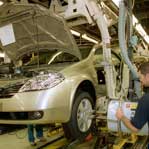 EU emissions threat to Britain's car industry?
EU emissions threat to Britain's car industry?The European Union's new plan, announced yesterday, to enforce an average emissions limit on new cars of 130g of CO2 per kilometre could present a major threat to a large part of Britain's specialist car industry.
While the EU Commission has apparently assured car-makers that the new limit will not apply to each individual manufacturer but to the industry as a whole, the exact terms of how the plan will be regulated are yet to be set out.
But the EU has a long record of making reassuring noises when announcing a new plan, yet the final law turning out - many months later, when press attention has died down - to be far more harmful.
If the law does take a per-manufacturer approach, the major car groups could more easily meet the average emissions requirement using the smaller city cars in their range to offset the emissions of their larger products.
But specialist sports and executive car makers like Britain's Aston Martin, Land Rover and Jaguar, as well as Britain's wide range of independent sports car makers, could be under threat.
While the big three mentioned above are currently all part of the Ford group, that doesn't make them secure. In a likely foretaste of what may happen if this new EU proposal comes into force, Ford is already trying to sell Aston Martin.
The question is, under the new EU law, could Ford cope with the sports and executive cars produced by these British brands at the higher end of their emissions range dragging up their average?
The same question must be asked in the cases of Bentley and Rolls Royce, owned by Volkswagen and BMW respectively.
If these groups feel they've reached the limit of what they can achieve with low-emissions city cars, disposing of their luxury higher-emissions brands could easily become an option.
Yet tens of thousands of jobs in Britain are connected with the manufacturing operations of these car-makers.
Weight -v- emissions: EU contradiction
The EU has also been accused of contradiction in its approach to the car industry. Car-makers have made huge progress in engine efficiency in recent years, reducing average car emissions from 185g/km of CO2 in 1995 to 162 g/km last year, and aiming for 140g/km by 2008.
But this progress has been hampered to some extent by the size and weight of cars increasing, caused in large part by ever more stringent EU-derived car safety regulations. More crash protection built into a car means more metal being used and a heavier vehicle is the result.
Obviously making safe cars is also a priority, but there's no evidence of a joined up approach to regulation between achieving this objective and reducing emissions - as to whether ever more EU demands for vehicle rigidity are worth the extra weight and emissions that inevitably result, relative to whether road casualties could be reduced in other ways.
EU's big business bias
Consultation on this new EU emissions plan will apparently continue, but danger is present in the way the EU law-making process favours large corporations with multi-billion pound budgets and professional lobbying outfits in Brussels.
The major car groups will inevitably command more attention from EU institutions and may be supportive of this new plan, if they were to see it as an opportunity to consolidate their market position by turning up the heat on their smaller competitors.
No comments:
Post a Comment